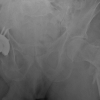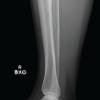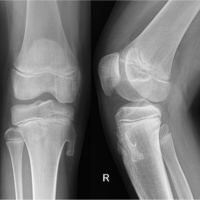In patients presenting with complicated rectal foreign bodies, a threaded rod may allow for less invasive extraction.
Dr. Roman M Natoli, Indiana University Health Physicians, Indianapolis, Indiana, United States/Department of Orthopedic Surgery, Indiana University School of Medicine, Indianapolis, Indiana, United States. E-mail: rnatoli@iuhealth.org
Introduction: Retained rectal foreign bodies (RFBs) can be difficult to extract, forcing the surgeon to get creative. This is the first case report utilizing orthopedic drilling and joystick manipulation techniques for foreign body extraction.
Case Report: A 63-year-old male presented to the emergency department with a pool ball in his rectum for 2 days. Extraction attempts under anesthesia both transanally and through a low midline laparotomy were unsuccessful due to the patient’s pelvic anatomy. Orthopedic surgery was consulted to see if any manipulation or resection of the pelvis might aid in extraction. Ultimately, a Schanz pin was drilled retrogradely from the rectum into the pool ball and successfully manipulated the pool ball out of the patient.
Conclusion: Techniques such as drilling and joystick manipulation are common in orthopedic surgery but rarely used in other surgical fields. This case presented a novel use of a Schanz pin in RFB extraction. Application of orthopedic surgical technique in a colorectal surgery in this case saved the patient from more invasive interventions such as pubic symphysiotomy or ischial tuberosity resection.
Keywords: Foreign body, laparotomy, rectum, Schanz pin.
Rectal foreign bodies (RFBs) are a modern problem with perennial roots, as the earliest documented instance dates back to the 16th century [1]. While there is a paucity of current data outlining the specific incidence of RFBs, a study from the University of Southern California reported seeing a RFB patient in their emergency department at a frequency of once a month [2]. Two additional independent studies demonstrated an overall increase in RFB hospital visits between 2008–2012 and 2010–2019 [3,4]. RFB patients are typically young and biologically male, with a possible disparity in sexes as high as six to one. There are a variety of documented motivations for the rectal insertion of objects, with the most common being sexual pleasure (35.8%). Objects rectally inserted in RFB hospital cases vary dramatically, with the most frequent being phallic items such as sexual devices, glass bottles, wooden objects, and food [5]. In some cases, medical devices have been discovered in rectally retained foreign bodies [6]. Management of RFB retention is a serious challenge for clinicians as the size and shape of the retained objects vary widely. Patients often delay treatment or attempt self-extraction, which may result in worsening injuries and further impede treatment. If improperly managed, RFB retention may pose serious complications to the patient, including hemorrhage, bowel perforation, fistula, acute renal failure, sepsis, and death. A meta-analysis of the currently available literature revealed a total RFB complication rate of 30.4%. The same study revealed that 45.2% of RFB cases require general anesthesia for removal, and 29.0% require sedation [5]. In healthy, stable patients, non-operative methods are attempted before escalating to surgery, but there are times when conventional surgical methods still fail to remove the foreign object [7]. In these challenging cases, surgeons must get creative with their arsenal of tools. This case report was approved by our local IRB, and informed consent was obtained from the patient.
A 63-year-old male presented to the emergency department with a pool ball in his rectum. He reported that his girlfriend had inserted a #14 pool ball into his rectum 2 days prior. On presentation, he had excruciating lower abdominal pain and difficulty with urination and bowl movement. On examination, he was in no acute distress, the abdomen was soft and non-distended, and there were no signs of hemorrhage. Plain pelvic radiography revealed a round, opaque foreign body in the pelvic cavity (Fig. 1). A Foley catheter retrieval of the pool ball was attempted without success, so the patient was moved to the operating room for foreign body extraction.
Under general anesthesia, the patient was placed in a high lithotomy position. The pool ball was palpable distally with a digital rectal examination; however, neither manual removal nor suction with an obstetrics vacuum extractor was successful in retrieving the pool ball transanally. The patient’s pelvic outlet was very narrow, and it became apparent that further attempts to reduce the ball through a transanal approach would continue to be unsuccessful; therefore, a low midline laparotomy was made. Unfortunately, the pool ball was found to be lodged in the rectum below the level of the peritoneal reflection, and the ball could not be manipulated to an intraperitoneal position for extraction through sigmoidotomy. Further attempts were made to deliver the ball through the transanal route, but the patient’s narrow pelvic outlet restricted movement past the ischial tuberosity. As the pool ball could not be moved either proximally or distally in the rectum, an orthopedic surgeon was consulted to see if any manipulation or resection of the pelvis might aid in the removal of the pool ball. It was determined that a pubic symphysis resection would not be of assistance in ball retrieval, but a partial unilateral resection of the ischial tuberosity may help. Since the patient had not provided informed consent for resection of the ischial tuberosity and was not positioned nor draped for such a procedure, a final transanal extraction attempt was made with a Schanz pin. A speculum was placed into the rectum so that the #14 pool ball was visible. The ball was held in place through the laparotomy opening, and then, a pair of ring forceps was inserted through the speculum to grasp the pool ball. A Schanz pin was then drilled into the pool ball. This rigid anchor allowed for good handling of the pool ball, which was wiggled past the ischial tuberosity and removed from the patient’s rectum through the transanal route (Fig. 2). Post-removal sigmoidoscopy revealed mild mucosal irritation but no perforations. Post-operatively, the orthopedic service recommended weight-bearing as tolerated. The patient’s recovery was complicated by ileus and anal fissures, but he eventually regained bowel function.
Transanal extraction of RFBs has a reported success rate of 60–75% [8]. A large variety of extraction techniques have been described: Kocher clamps, various grasping forceps, balloon catheters, suction devices, or downward abdominal pressure are all common methods [7,9-11]. For spherical objects, laparoscopic extraction bags [10] and endoscopic retrieval tools [11] have been used successfully. In one patient with a narrow pelvic outlet, the impacted plastic ball was carefully cut into pieces and then extracted [6]. When conventional methods fail, RFB removal with a Schanz pin is a novel approach to consider in cumbersome cases. In this particular case, the slippery sphere combined with the patient’s narrow pelvic outlet resulted in a three-hour-long exercise in frustration before the Schanz pin method was attempted. Although a pair of forceps did not have enough grip on the ball to pull it out, it was enough to prevent the ball from rotating and being pushed deeper while drilling. The ball was palpable on a rectal examination and visible when the speculum was placed. This placement allowed for a successful transanal extraction with the Schanz pin. Bullets have similarly been removed by orthopedists using terminally threaded guidewires [12]. There are risks in using a high-powered rotary tool next to soft mucosal tissue. When drilling into a hard and slippery object, such as a pool ball, uncontrolled slippage of the drill bit could lead to perforations of the rectum. In addition, the higher torque transfer could overpower the clamping force of the forceps, leading to sudden rotation of the foreign body, which could cause mucosal tearing. Foreign body extraction with a threaded rod is only applicable to a limited set of materials. First, the foreign body material must be drillable. This excludes any objects containing batteries and brittle materials, such as glass. Second, the material should allow for secure anchoring of the rod. In the presented case, the pool ball’s hard plastic material was malleable enough to allow thread cutting without cracking and was tough enough to prevent the Schanz pin from stripping out the threads and pulling through. For harder materials, pre-drilling may be required, whereas for softer materials, coarser threads may provide a stronger anchor. This method would not be suitable for thin-walled objects such as bottles or bags.
In the presented case, the patient’s unique anatomy, the shape and texture of the pool ball, and the unfortunate depth where the ball was stuck made the ball unrecoverable through conventional methods. However, the rigid plastic material and depth of impaction also allowed for retrieval with a Schanz pin, sparing the patient from more invasive procedures such as a partial unilateral resection of the ischial tuberosity. A threaded rod such as a Schanz pin is a new tool to consider in difficult cases of RFB extraction.
Surgical retrieval of rectal foreign bodies can be met with complications related to the patient’s individual anatomy or the nature of the foreign body. In these difficult emergent situations, using a Schanz pin is a novel approach that may permit safer retrieval of foreign bodies.
References
- 1.Gould GM, Pyle WL. Anomalies and Curiosities of Medicine: Being an Encyclopedic Collection of Rare and Extraordinary Cases, and of the Most Striking Instances of Abnormality in all Branches of Medicine and Surgery, Derived from an Exhaustive Research of Medical Literature from its Origin to the Present Day, Abstracted, classified, Annotated, and Indexed. Philadelphia, PA: W. B. Saunders; 1897. p. 645-8. [Google Scholar]
- 2.Lake JP, Essani R, Petrone P, Kaiser AM, Asensio J, Beart RW Jr. Management of retained colorectal foreign bodies: Predictors of operative intervention. Dis Colon Rectum 2004;47:1694-8. [Google Scholar]
- 3.Ayantunde AA, Unluer Z. Increasing trend in retained rectal foreign bodies. World J Gastrointest Surg 2016;8:679-84. [Google Scholar]
- 4.Bhasin S, Williams JG. Rectal foreign body removal: Increasing incidence and cost to the NHS. Ann R Coll Surg Engl 2021;103:734-7. [Google Scholar]
- 5.Ploner M, Gardetto A, Ploner F, Scharl M, Shoap S, Bäcker HC. Foreign rectal body - Systematic review and meta-analysis. Acta Gastroenterol Belg 2020;83:61-5. [Google Scholar]
- 6.Asmar N, Perrod G, Rahmi G, Cellier C. Hip orthopedic material presenting as an unusual rectal foreign body. Ann Gastroenterol 2018;31:751. [Google Scholar]
- 7.Athamnah MN, Rabai NA, Al Azzam HS. Rectal foreign body, an impacted plastic ball: A case report and review of literature. Int J Surg Case Rep 2021;87:106404. [Google Scholar]
- 8.Cologne KG, Ault GT. Rectal foreign bodies: What is the current standard? Clin Colon Rectal Surg 2012;25:214-8. [Google Scholar]
- 9.Goldberg JE, Steele SR. Rectal foreign bodies. Surg Clin North Am 2010;90:173-84, Table of Contents. [Google Scholar]
- 10.Chilakamarry S, Klipfel AA. Novel approach to removal of rectal foreign bodies. Dis Colon Rectum 2021;64:e368-70. [Google Scholar]
- 11.Park YJ, Baek DH, Park EY, Kim GH, Song GA. Unusual rectal foreign body: A golf ball. Clin Endosc 2021;54:291-2. [Google Scholar]
- 12.Lee GH, Virkus WW, Kapotas JS. Arthroscopically assisted minimally invasive intraarticular bullet extraction: Technique, indications, and results. J Trauma 2008;64:512-6. [Google Scholar]









